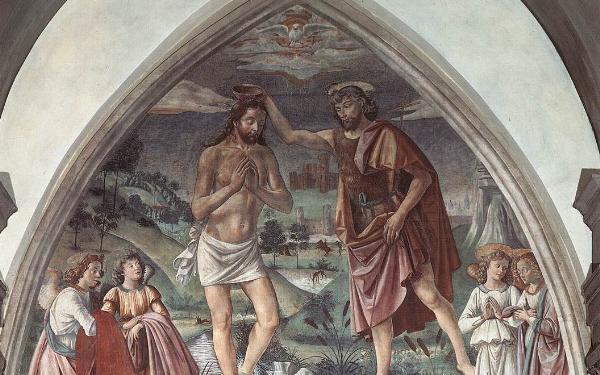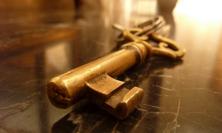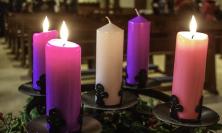What do we learn about John the Baptist from the gospel passages about him that will be read over the following two Sundays? As we continue our liturgical journey through Advent by hearing about this man who ‘was clothed with camel’s hair...and ate locusts and wild honey’, Peter Edmonds SJ looks at how each gospel writer’s portrayal of him can help us in a different aspect of our preparation for the coming of Christ.
Every year in the Lectionary used in Catholic churches all over the world, the gospel readings on the second and third Sundays of Advent have as their main focus John the Baptist. Who was this man and how does he come across in the various passages from the gospels read on these days? Have we anything to learn from him today?
We learn who he was from the Jewish historian, Josephus. Writing about the death of John the Baptist at the hands of Herod Antipas, the ruler of Galilee, he remarks about John, ‘He was a good man and had exhorted the Jews to lead righteous lives, to practice justice towards their fellows and piety towards God, and so doing join in baptism. . .’ (Josephus, Antiquities 18.5.2). Josephus was only interested in John because he was part of the story of Herod Antipas, the ruler in Galilee, who saw him as a threat. Likewise, the evangelists include John in their gospels because of the role he played in the life of Jesus. We read about him in the Sunday Lectionary because the story of his ministry can enrich our preparation for Christmas during the season of Advent.
We prepare for Easter by the observance of Lent, traditionally a time of penance and mortification. The season of Advent, too, includes an invitation to personal penance and reconciliation with God and neighbour. This theme is most prominent on its second Sunday. The word ‘Repent’ occurs in each of three gospel passages of the three year cycle; the context is the desert preaching of John the Baptist which came to its climax in the Baptism of Jesus in the River Jordan. Let us consider the three accounts we hear of this preaching: in Year A of the cycle (in which we find ourselves now), we hear Matthew’s version; in year B, Mark’s; and in Year C, Luke’s.
The Second Sunday of Advent
Year A: Matthew 3:1-12
In those days John the Baptist appeared in the wilderness of Judea, proclaiming, ‘Repent, for the kingdom of heaven has come near’.
Matthew’s version of the tradition has much in common with Mark’s, but we should note important differences. For Matthew, John is a Christian preacher because his initial proclamation is the same as that of Jesus (4:17): ‘Repent, for the kingdom of heaven has come near’ and is identical to that which Jesus told his disciples to make when they went out on their mission (10:7). Further, John addresses the Pharisees and the Sadducees (3:7) with the same fierce title with which Jesus will challenge the Pharisees; they were a ‘brood of vipers’ (12:34; 23:33). John makes the same complaint about them (3:8) which Jesus will make; they do not produce fruit worthy of repentance because, as Jesus told his critics, ‘the tree is known by its fruit’ (12:33). Just as Jesus warned in his parables about wheat and weeds growing in the same field, symbolic of the mixed response his preaching would receive (13:36-43), so too the message of John provoked a mixed reaction. The ordinary people of Jerusalem accepted it, but the Pharisees and Sadducees did not. But one aspect of John’s preaching might make us uncomfortable: he seemed to view Jesus exclusively in terms of judgment and vengeance. His baptism of the Holy Spirit and fire would conclude with the chaff being burnt with unquenchable fire (3:12).
Matthew’s portrayal of John as a Christian preacher has been ratified by Christian tradition. John is commemorated as a saint in the Christian calendar with two feasts in the year, one commemorating his birth on 24 June and the other his death on 29 August. He is the only saint in the calendar, apart from the mother of Jesus, to have two days set apart in his honour. His call for repentance ‘because the kingdom has come near’, sums up at least part of the Advent message.
Year B: Mark 1:1-8
Now John was clothed with camel’s hair, with a leather belt around his waist, and he ate locusts and wild honey.
The key word for describing Mark’s understanding of John the Baptist in his gospel is ‘forerunner’. In the words of the scripture which are quoted, John was the messenger sent ahead and he was the prophet preparing the day of the Lord (Exodus 23:20; Malachi 3:1). In John’s own words, the Lord was the one who ‘was coming after’; he pointed to the one who was stronger, ‘more powerful’. This was Jesus on whom the Spirit would fall, and who, by expelling the demons, would enter the house of the strong man (Satan) and plunder his property (3:28). John had a baptism with water but Jesus would baptise with the Holy Spirit. John had disciples who fasted, but Jesus was the bridegroom and the bridegroom’s guests did not fast (2:18-22). All Jerusalem went out to hear John and be baptised, but people from every corner of the Holy Land would come to Jesus (3:8). John would be put to death by Herod, but Mark tells the story in a way that makes clear that this death was but a prelude to the passion and death of Jesus (6:14-29).
On the 2nd Sunday of Advent, hearers of this gospel are urged to follow the example of ‘people from the whole Judean countryside and all the people of Jerusalem’ in seeking to renew the spirit of their own baptism and to confess their sins. In this way, they will be prepared to greet Jesus, not, as in the gospel when he came from Nazareth to John for baptism (1:9), but in his birth in our own world at Christmas time.
Year C: Luke 3:1-6
The word of God came to John, son of Zechariah, in the wilderness.
At first sight, the account that Luke offers in Year C of the ministry of John the Baptist has much in common with those found in Matthew and Mark, heard in Years A and B, respectively. He too has John proclaiming a baptism of repentance for the forgiveness of sins. But we may note three additions that Luke, the most literary and historically sensitive of gospel writers, makes to the story given us by Matthew and Mark. First, he gives a list of the powerful people in the world of the time, from Tiberius, the emperor in Rome to Annas and Caiphas, the high priests in Jerusalem. Secondly, he extends the quotation from Isaiah found in other gospels to include the lines about mountains being lowered and valleys filled (Isaiah 40:3-5). This is the message of Mary in her Magnificat about the powerful being brought down from their thrones and the lowly being lifted up (1:52). Thirdly, he extends the quotation of the words of Isaiah to include his verse about all flesh seeing the salvation of God.
Through these additions, Luke adds a universal dimension to the familiar story. He places John the Baptist into world history and makes us wonder why, with so many powerful people around, God chose to send his word to a person like John. This new information encourages us in our Christmas preparations to gaze outside our small world at the big world outside, and to grasp how the Christmas story is a gift for the whole of humanity and no mere domestic celebration. He reassures readers from whatever nation or class they came, that ‘these things did not happen in a corner’ as Paul would tell Festus and Agrippa, the Roman governor and the Jewish king, respectively (Acts 26:26). John’s message of repentance for the forgiveness of sins is for all.
The Third Sunday of Advent
Masters of the life of the Spirit tell us that repentance is the first stage of the Christian life, and this may well be the fruit of meditation on the lasting values of the gospel readings for the second Sunday of Advent. On the third Sunday, still with John the Baptist for our guide, we move on to consider further stages of Christian commitment.
Year A: Matthew 11:2-11
Go and tell John what you hear and see. The blind receive their sight, the lame walk, the lepers are cleansed, the deaf hear, the dead are raised, and the poor have the good news brought to them.
John the Baptist is now in prison. He was there as a result of a confrontation with Herod Antipas, the local ruler. John had rebuked him about his marriage to the wife of his brother. His was no cheerful imprisonment like that of Paul (Philippians 1:12): his earlier confidence in Jesus was evaporating. He was no longer certain that Jesus was the one who was to come. He could see no sign of the one whom he had expected to appear with a winnowing fork in his hand, in order to burn the chaff with unquenchable fire (3:12).
Jesus had to convince him that his mission was primarily one of healing and mercy; he was the servant Isaiah spoke of who himself ‘took our infirmities and bore our burdens’ (8:17; Isaiah 53:4). Matthew’s audience has been led through two whole chapters relating the powerful healing activities of Jesus (8:1-9:35), who would soon sum it all up in his invitation, ‘Come to me, all who are weary and carrying heavy burdens, and I will give you rest’ (11:28). Jesus did not condemn John for his lack of understanding; he had this to say in his praise: ‘Among those born of women no one has arisen greater than John the Baptist; yet the least in the kingdom of heaven is greater than he’ (11:11).
We all know how enthusiasm for a new cause can turn cold. The cost and weight of commitment can at times seem heavier than the immediate reward. Certainly Paul had to deal with this phenomenon among his converts and it would be surprising if Matthew did not have to do so too. In the stress that the Christmas season brings for many, it is good to remind ourselves of this message of Jesus to John. He puts it in the form of a beatitude, ‘Blessed is any one who takes no offence at me’ (11:6).
Year B: John 1:6-8, 19-28
He came as a witness to testify to the light, so that all might believe through him. He himself was not the light, but he came to testify to the light.
Two passages from John are combined to make up the gospel reading for the 3rd Sunday of Advent in Cycle B. In the first, we are told both what John the Baptist was and what he was not. He was a witness. This is a legal term, and it has been seized upon as part of the evidence for understanding the whole of John’s gospel as the account of a trial. Jesus is on trial from its beginning and John is his first witness. In the Acts, we read of Paul, years later, meeting disciples of John the Baptist in Ephesus (Acts 19:3). Right at the beginning of his gospel, John makes it clear that the Baptist was not the light: Jesus was the light, as he was to proclaim publically in his ministry when he spoke out in Jerusalem, ‘I am the light of the world’ (8:12).
In the second passage, we are again told who John was not. He was not the Messiah (like some King David), nor was he Elijah, and he was not a prophet like Moses (Deuteronomy 18:15). For this gospel, Jesus fulfils, completes and goes beyond the person and mission of all such figures. John will soon witness to his own disciples how Jesus was the Lamb of God (1:35). His role will be summed up in his own words, ‘He must increase, I must decrease’ (4:30). He has no further part to play in this gospel, although Jesus will refer to his activity as witness after his healing the cripple by the pool of Bethzatha: ‘You sent messengers to John, and he testified to the truth’ (5:33).
The humility of John is a challenge to everyone with a part to play in the mission of the Church, but it is no passive humility. Whoever wrote the gospel according to John was quite convinced of the Christian need to witness. This is what the community does at the beginning of the first letter of John: ‘We declare to you what we have seen and heard’ (I John 1:3). May the Christian communities of today continue this mission of witness in a hostile and unbelieving world.
Year C: Luke 3:10-18
And the crowds asked him, ‘What then should we do?’
The reading for the 3rd Sunday of Advent from Luke is unusual in that it is almost a continuation of that of the previous Sunday (the ‘brood of vipers’ passage we have already heard from Matthew in Year A is omitted), and in this continuation we hear the preaching of John the Baptist which we find nowhere else.
Three groups come to John asking him what they were to do. John gives appropriate advice to each of them: the crowds were to share clothing and their food with those who lacked them; tax collectors were to collect no more money than was due; and soldiers were to refrain from oppression and to be content with their pay. The same question, ‘What must we do?’ occurs later in Lucan writings. When a lawyer asks Jesus what he is to do, Jesus replies with the parable of the Good Samaritan (Luke 10:25-38) and the lawyer is instructed to do likewise. When Peter is asked the same question on Pentecost Day, he tells the crowds, ‘Repent and be baptised every one of you in the name of Jesus Christ’ (Acts 2:38); Peter is speaking not of the baptism of John but the baptism with the Holy Spirit and fire that John foretold Jesus would offer.
Here is a call for social responsibility appropriate for Advent. Religion is not just something for Sunday and chapel, but is to inform our everyday activity, even our employment. Certainly the ethical message of the Baptist was overshadowed by that of Jesus, but it prepares us for it, just as the teaching of the prophets of Old Testament maintains its validity. In this gospel of Luke, Jesus explained that ‘the law and the prophets were in effect until John came; since then the kingdom of God is proclaimed’ (16:16). For Luke, John belonged firmly to the old dispensation. He prepared the way for the kingdom.
In the 4th Sunday of Advent, we enter directly into the Christmas story by hearing the gospel accounts of the angelic annunciations to Joseph (Year A: Matthew 1:18-24) and to Mary (Year B: Luke 1:26-38), and of the meeting of the mothers of John the Baptist and Jesus (Year C: Luke 1:39-45). May reflection on the preaching and career of John the Baptist on previous Sundays deepen our understanding of the Christmas mystery.
Peter Edmonds SJ is tutor in Biblical Studies at Campion Hall, Oxford.






